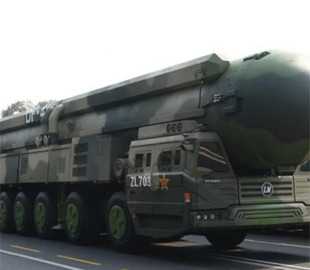>> The US warns of a significant increase in Chinese nuclear installations” />
The growing strength of China's nuclear potential continues to attract the attention of major powers, especially the United States. According to a recent report by the US Defense Intelligence Agency, China is engaged in the fastest and most ambitious modernization of its nuclear arsenal in the country's history. Due to the desire to compete strategically with the United States, Beijing has invested heavily in the development of new nuclear weapons, deploying a number of advanced technologies that significantly strengthen its position on the world stage.
One of the most notable events – the rapid expansion of China's stockpile of nuclear warheads, which now exceeds 500. According to US estimates, this number may reach 1,000 warheads by 2030, which is largely due to the expansion of the arsenal of intercontinental ballistic missiles (ICBMs), such as the DF-31 and DF-41, capable of reaching targets on US territory.
Tested outside China's borders for the first time in 40 years, the DF-41 represents a significant technological advance, equipped with MIRVs (Multiple Independently Targeted Missiles), allowing it to hit multiple targets simultaneously with a single launch.
On land, China has created an extensive network of underground mines for its ICBMs. The US report details the construction of a massive complex of 120 mines in Gansu province designed to host intercontinental ballistic missiles such as the DF-31 and DF-41, marking the largest expansion of China's land-based nuclear capability in history.
Additional brigades were established equipped with the DF-26, an intermediate-range ballistic missile (IRBM) capable of both nuclear and conventional strikes. The DF-26 offers enhanced accuracy with a range error of less than 100 meters, allowing China to diversify its strategic strike options while strengthening its defensive posture against the United States and its allies.
200% Deposit Bonus up to €3,000 180% First Deposit Bonus up to $20,000The DF-26 mobile launcher also plays a critical role in this military build-up. This system, successfully deployed in 2019, can deliver precision strikes against both land and sea targets with a maximum range of 5,000 kilometers. This long-range strike capability, combined with unit mobility, gives the People's Liberation Army (PLA) considerable strategic flexibility, strengthening its nuclear deterrent and defense network.
At sea, China continues to build up its nuclear potential. Two new Type 094 JIN nuclear-powered submarines have entered service, bringing the total number of these submarines capable of patrolling the high seas to six. These submarines are equipped with the JL-3 submarine-launched ballistic missile (SLBM), an upgraded version of its JL-2 predecessor, which offers greater range and the ability to engage US targets from protected areas such as the South China Sea. . The growth of these submarine forces allows China to maintain a permanent deterrence capability through regular patrols in international waters.
In parallel, Beijing has developed a new air component of its nuclear triad with the H-6N strategic bomber capable of in-flight refueling and carrying a ballistic missile air launch. This capability was demonstrated during the 2019 national parade, which marked a change in the country's air military strategy. As a key element of China's aerial nuclear strike force, the H-6N provides Beijing with additional flexibility for nuclear operations.
China's nuclear arsenal is not limited by the number of warheads or delivery systems. The country is also exploring the development of low-yield nuclear warheads, offering more proportionate response options, particularly in the context of regional military conflicts or limited pre-emptive strikes. This diversification of nuclear capabilities allows China to consider a wide range of military scenarios while increasing the complexity of strategic calculations for its adversaries.

